SharePoint Public Websites in Office 365
Update:
Starting in January 2015, Microsoft is making changes to the SharePoint Online Public Website feature. Office 365 customers who currently use the feature will continue to have access to the feature for a minimum of two years following the changeover date. Microsoft will offer alternate solutions from industry leaders to enable Office 365 customers to easily integrate public websites with their Office 365 service.
Hi, my name is Kevin Gjerstad, and I’m a Principal Program Manager in the SharePoint Internet Business Group. It’s exciting to begin to take the wraps off of the new SharePoint Online Public Website feature. I’m going to walk you through the latest advancements coming to SharePoint Online as part of Office 365—sharing new, exciting ways you can represent your public image and information to your clients, customers, and partners.
All new, all SharePoint, all in the cloud
One of our primary objectives with this release was to make the Public Website a first-class citizen of SharePoint Online (SPO) and Office 365 (O365). So, our first step was to rethink it as a highly customizable solution of SPO—building on the core SharePoint publishing portal engine. This means that the Public Website in O365 can now fully access SharePoint Online—benefitting from many feature investments in content management, social integration, the Cloud App Model, performance, design customization, SEO, and more. This also means the Public Website can be customized using many of the same tools and techniques used to customize any SharePoint-based site, adding to the value of your overall O365 investment.
Tools for creating modern, professional-looking sites, simply
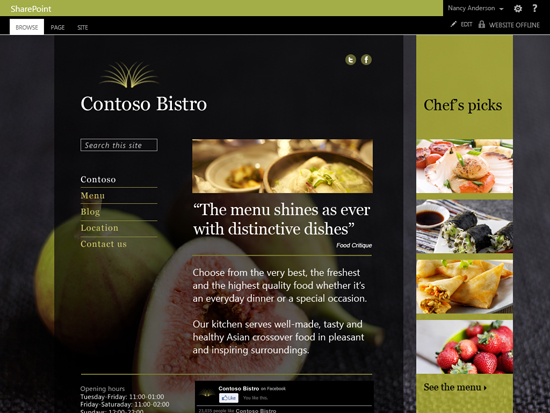
When you navigate to your Public Website for the first time, you’re taken to the home page with a default look and feel and placeholder content. Once there, you’ll immediately notice the editing user interface seems very familiar. You can add and edit webpages and images, and embed videos and Office documents, custom applications, Web Parts, and more using the website editor toolbar. And, while the interface is familiar, we recognized not everyone is a web developer, a SharePoint expert, or a CSS guru. We carefully crafted the editing and site management user interface to give you just what you need, and hopefully not a lot of stuff you don’t want when building a site. But there is a lot more power and flexibility to do more if you want to get under the hood, and I’ll touch on that later.
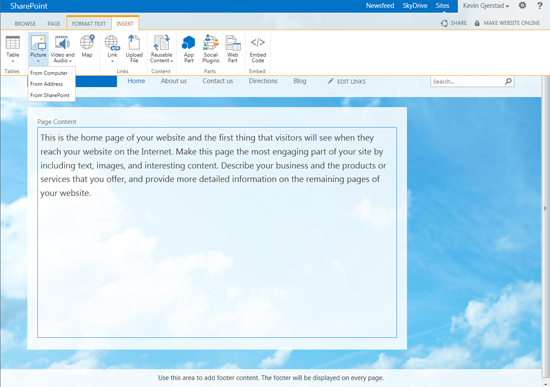
First impressions matter a lot for business websites. For better or worse, visitors often judge by how a site looks. With this in mind, a key design principle for us was to let users of all types create compelling, professional-looking sites quickly and easily. You get a selection of site designs to choose from, a rich set of carefully selected color palettes, and appropriate fonts. You can select from a list of pre-made starting points that are designed to ensure consistent layout, typography, font size, color schemes, and legibility. You can preview a design and make further refinements to the colors, fonts, background, and so on, by using the “Choose the Look” feature. (We have a few designs in the Preview and more coming in the future.) After you’ve settled on a look, you can then brand the site with a background image, logo, title, navigation, custom pages, and content—all using just your web browser. With these simple tools, you can build an elegant-looking site quickly.
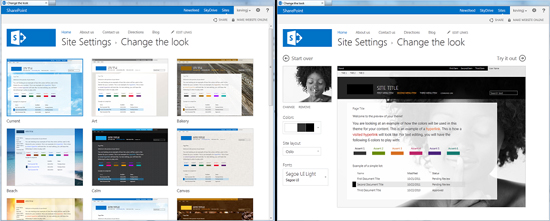
If you want to do more, there is a set of tools you can use to get under the hood. For example, you can always get to the underlying HTML for the page or content region and make edits directly to the markup. You can also tweak the CSS for the site or the page, using the “Edit Style Sheet” feature from the toolbar. Changes are applied on-the-fly so you can see how the site looks as you make the changes. You can also add JavaScript to the page to add more interactivity.
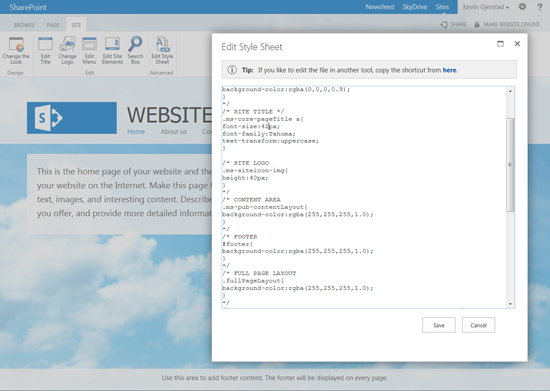
You can also use the new Design Manager tool to completely change your site design or create a new design. Web developers and designers can edit in HTML using their favorite tools (such as DreamWeaver, Expression Web, or just Notepad) and SharePoint Online converts these files automatically. SharePoint Online provides a Snippet Gallery that designers can use as a reference to configure and then copy/paste web controls, Web Parts, and other aspects of a site design into page layouts.
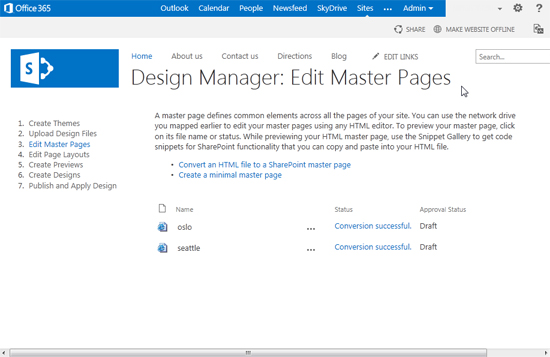
SEO, blogs, and social
Having a compelling site doesn’t matter much if people can’t find it. The Public Website benefits from substantial web content management (WCM) investments in search engine optimization (SEO) to make it easier for Internet search engines to crawl content in SharePoint Online. This includes presenting friendly URLs for pages like “http://www.contosobistro.com/contact-us” and changes to the page markup that make them more SEO-friendly. To help search engines discover the relevant pages in your site, you can choose to have SharePoint Online generate a comprehensive extensible markup language (XML) sitemap. And, you can use the SEO tools to make properties like meta description and keywords more discoverable by search engines. Together, these changes give you the tools to ensure your site can be found from a web search. Of course, it’s up to you to create compelling content and follow SEO content authoring guidelines. (We recommend you use the SEO evaluation tools freely available on the Internet to monitor the SEO of your site.)
Having an active blog on your Public Website can also improve your SEO. SharePoint Online Public Websites are automatically provisioned with a blog feature complete with a blog post summary page and blogging tools. As with regular content pages in SharePoint Online, blog posts get friendly URLs (“http://www.contosobistro.com/blog/post/2/our-new-menu”). You can use the full-featured, browser-based rich text editor to edit posts or you can use Word to author and publish blogs. It’s super easy to embed multimedia content including images, maps, video, and more. Blogs on Public Websites have several other useful features including real simple syndication (RSS), which helps your users subscribe to real-time information about your posts. And we’ve pre-integrated the Facebook comments social plugin within the Blog feature to make commenting for anonymous users very simple.
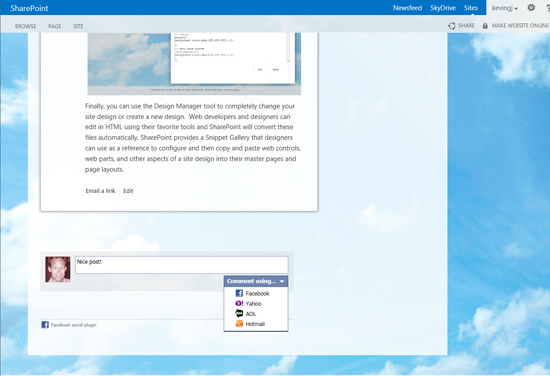
Beyond SEO, social networks have become increasingly important to attract new customers, increase awareness and reach, and tighten communication with existing customers. So, we’ve made it easy for you to add social plug-ins—the Like button, newsfeed, and comments—anywhere on your site. You simply add a social integration application from the SharePoint App Store and then drop the desired social plugin on the page using the ribbon UI. The social integration applications automatically promote page properties as Facebook metadata, which lets you control exactly what gets published to the corresponding social network. If you have a Facebook page for your company, you can do even more with this integration.
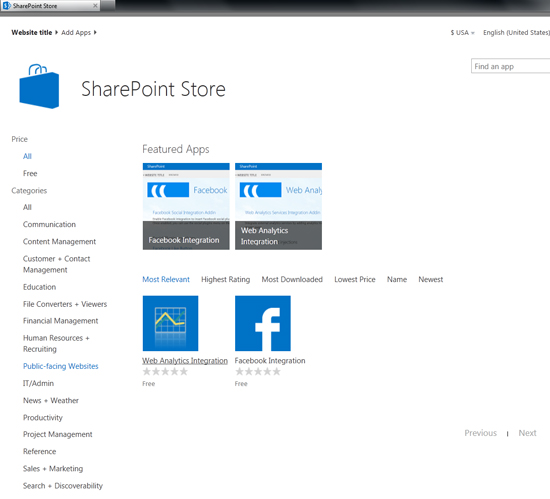
Apps and extensibility
The social integration apps are some of the first apps available in the SharePoint Store for public-facing websites, and more are coming. SharePoint apps are easy to purchase and install and can be used to extend the functionality on your site and to get the most out of the full Office 365 suite. For example, you can choose to use the Azure AutoHosted option to host your solution as a proxy between the Public Website (accessible to anonymous users) and a Team site (private to your organization). This is simple to use and all of the connection setup work is done for you. This pattern enables you to manage your data (for example, customer or product data) securely, take in information from anonymous users, and publish or make available select data to the Public Website .
The new cloud app model opens up many opportunities for solution providers. Expect to see a lot of innovation with apps for the Public Website in the new SharePoint Store.
So now you have the overview of what’s new with Public Website in O365. There’s a lot more to tell you about, so we’ll be adding more posts in the coming weeks. Let us know what you think.
